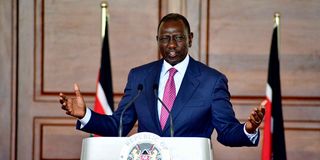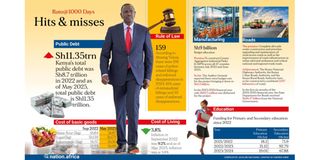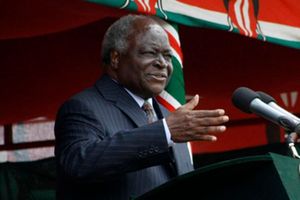
President William Ruto during the Ministerial Performance Contracts for the FY 2024/2025 at State House, Nairobi on November 19, 2024.
President William Ruto rode to power on lofty promises, projecting himself as the champion of the majority poor, but an assessment of his midterm record shows missed targets and public discontent that boiled over last year during bloody nationwide anti-tax riots.
He framed the 2022 presidential election as a contest between the poor and the rich, riding on the “hustler vs dynasty” narrative, with a promise to create jobs for millions of unemployed youth and prioritising the needs of low-come earners.
Two-and-a-half years in office, the country is divided on whether he has delivered on his pre-election promises. His critics have handed him nicknames such as Zakayo (biblical tax collector), Kasongo, El Chapo among others to mock him for his appetite for taxes and promises.

An assessment of President William Ruto’s midterm record.
In his first budget for the 2023/2024 financial year, his government introduced new tax measures, including an increase of Value Added Tax (VAT) on petroleum products from 8 per cent to 16 per cent.
Salaried Kenyans now have a substantially reduced take-home after the introduction of several new levies, including a 1.5 per cent Housing Levy, 2.7 per cent Social Health Insurance Fund (SHIF) and enhanced National Social Security Fund (NSSF) deductions. Additional tax measures in the Finance Bill, 2024 triggered a nationwide youth-led protest forcing the President to reject it.
Some of his former allies in the Kenya Kwanza administration have since become his fiercest critics, blaming him for running down the economy through punitive taxes.
But President Ruto has continued to paint a rosy picture of the country’s direction, maintaining that his administration is still on the path to improving the living standards of the downtrodden through its Bottom-up economic model (Beta).
Affordable housing
“We will increase the supply of new housing to 250,000 per annum and the percentage of affordable housing supply from 2 per cent to 50 per cent. We will achieve this by structuring affordable long-term housing finance schemes including a National Housing Fund and Cooperative Social Housing Schemes that will guarantee offtake of houses from developers,” states the Kenya Kwanza manifesto.
Upon assuming office, the figure was revised downwards to 200,000 units per year. The administration then introduced the Housing Levy of 1.5 per cent of employees' monthly gross salary, matched by employers.
The administration, through Deputy Chief of Staff, Performance and Delivery Management Eliud Owalo, said a total of 148,165 units are currently under construction. In his Madaraka Day speech, the President said his administration is firmly on course to delivering 150,000 housing units under the programme. He said 11,000 units are already completed.

President William Ruto during the handover of 1,080 homes built under the Affordable Housing Programme in Mukuru, Nairobi on May 20, 2025.
This is a major shortfall on what was promised—based on the 200,000 units per year, the government should have constructed at least 500,000 units by April this year.
Housing and Urban Development Principal Secretary Charles Hinga told the Nation that since 2022, the programme has created over 250,000 direct and indirect jobs for Kenyans.
“The AHP has incorporated MSMEs [micro, small and medium enterprises] and Jua Kali into the production of ring-fenced goods and services. We have ring-fenced Sh11 billion for Jua Kali and MSMEs in our ongoing affordable housing projects nationwide. This money will be paid to these MSMEs to construct, among other items, steel doors, windows, balustrades, curtain rods, and provide landscaping services,” said Mr Hinga
However, the 2025 Economic Survey by Kenya National Bureau of Statistics report shows that jobs in the construction sector reduced last year.
“The construction sector declined by 0.7 per cent in 2024 compared to 3 per cent growth registered in 2023. There has been a reduced momentum in both public infrastructure projects and private sector developments that signalled a period of adjustment for the industry,” it says, casting doubt on the number of jobs created.
Hustler Fund
In its manifesto, Kenya Kwanza says: “We will commit Sh50 billion a year to provide MSMEs with 100 per cent access to affordable finance through Saccos, venture capital, equity funds and long-term debt for startups and growth oriented SMEs.”
Hustler Fund was launched by the President on November 30, 2022, and made available through mobile money platforms. But the kitty has continued to suffer major funding cuts amid non-repayment by borrowers.
In the financial year ending June 2023, Sh12 billion was allocated to the fund. In the subsequent year, only Sh800 million was allocated. In the new financial year starting July 1, the fund has been allocated Sh1 billion against a request of Sh5 billion.

President William Ruto during the launch of the Hustler Fund at Green Park, Nairobi, on November 30.
MSMEs Development Principal Secretary Susan Mang’eni recently told MPs that the government was seeking to write off bad loans amounting to Sh6 billion borrowed by 10 million Kenyans.
Government data shows that the fund has supported over 25 million borrowers, with a total disbursement of Sh70 billion.
Mr Owalo told the Nation that individual beneficiaries currently stand at 25,944,447. He said a total of 872,672 groups have benefited from the Hustler Fund with Sh196,503,657 disbursed to them.
Agriculture
Kenya Kwanza promised to transform two million poor farmers from a food deficit to surplus producers through inputs finance and intensive agricultural extension support. The target was a minimum productivity target of Sh50,000 per acre.
According to Mr Owalo, the government has implemented the fertiliser subsidy programme and has 53.6 million farmers currently registered.
“The subsidy programme has realised a substantial reduction in the cost of fertilisers, with a 50kg bag dropping by 67 per cent from Sh7,500 in 2022 to Sh2,500. Farmers have benefited from lower input costs, leading to increased crop yields, higher profit margins and improved financial stability,” he said.
The subsidy program was, however, marred with an alleged corruption scandal after former Deputy President Rigathi Gachagua claimed the fertiliser that was sold to farmers was a donation.
“The Russian government gave us 40,000 tonnes of fertiliser as a donation. It was given to Maisha Minerals by the President and another 30 tonnes were given to these men, who blended and sold to the government,” Mr Gachagua said in a recent interview.
Similar claims were made by then opposition leader Raila Odinga.
In his Madaraka Day speech, President Ruto said the fertiliser subsidy had boosted food production by 50 per cent. He also said reforms in the coffee and sugar sectors had revived local industries, enhanced farmer incomes and created jobs.
“Today, milk farmers are earning Sh50 per litre, up from Sh35. Coffee farmers are now earning up to Sh150 per kilo, a remarkable increase from an average of Sh65. Tea earnings rose from Sh138 billion in 2022 to Sh215 billion in 2024. Sugar production surged from 490,000 tonnes in 2023 to 815,000 tonnes in 2024,” he said.
Healthcare
Upon assuming power, President Ruto’s administration embarked on the implementation of mandatory Social Health Insurance Fund (SHIF) under the Social Health Authority (SHA).
But the transition from the defunct National Health Insurance Fund has been characterised by major implementation hiccups. Despite paying monthly premiums, which have significantly increased for a majority in formal employment, patients have been unable to access timely treatment due to system failures. Previously, salaried Kenyans were paying a flat rate of Sh1,700. But the new rates mean that a worker earning Sh100,000 now contributes Sh2,700.
A report by the Rural and Urban Private Hospital Association of Kenya after a survey conducted in December 2024 also revealed that nine out of 10 private and public facilities were struggling to meet their operational costs due to delayed payments by SHA.
An assessment of President William Ruto’s midterm record.
A total 8,571 medics employed under the universal health coverage plan have also been on the streets as national government and counties tussle over their employment. The medics were hired at the height of the Covid-19 pandemic in 2020 and have remained on contract since.
The government, while acknowledging some of the initial challenges with SHA, noted that targeted interventions are underway to streamline operations and enhance service delivery. A total of 23 million Kenyans have so far been registered under the new scheme. President Ruto said that official data shows an average of 50,000 new registrations daily.
“There have been no reported cases of system downtime for months. The Digital Health Agency is working to roll out biometrics across the hospitals and reduce dependence on OTPs. This will make the system 99.999 per cent and eliminate any delays in the provision of care,” said Health Cabinet Secretary Aden Duale.
“The activation of the SHA accounts for Kenyans once they pay is real time and there is no delay. However, we have noted the delay in remittances of SHA deductions by the employers by the 9th day of every month as required by the law. We urge all employers to ensure they remit deductions on time to ensure their staff access services without any issue,” he told the Nation.
Education
In its manifesto, Kenya Kwanza committed to bridge the teacher shortage gap of 116,000 within two financial years and review the exam-based system of academic progression by implementing alternative entry criteria.
Further, it committed to improve the capacity of day secondary schools to guarantee access to quality education and reduce the cost of education, and establish the National Skills & Funding Council and increase funding to bridge the current 45 per cent gap.
On assuming power, President Ruto introduced a new university funding model, which was immediately rocked with major challenges and court battles.
The Kenya Human Rights Commission, Elimu Bora Working Group and the Students’ Caucus challenged the model. They argued in court that it transferred the responsibility of providing education from the State to parents. But the government defended the system arguing that the previous one had become ineffective.
The Ruto administration is also struggling to finance learning in public schools. Education CS Julius Migos told MPs that the government owes schools Sh64 billion in undisbursed capitation over the last nine years.
“We need to discuss how we can fund the education sector in the country. Persistent underfunding affects the quality of education,” said Mr Migos.
But in his Madaraka Day speech, President Ruto talked of major transformation in the sector, saying “our children are getting quality, relevant education.”
“By January 2026, we will have employed 100,000 teachers, the highest number in our nation’s history, to help build the workforce of the future,” President Ruto said.
Further, the government said a total of 16,000 classrooms have been constructed for junior schools, thus improving the learning environment and increasing the transition rate to 99.1 per cent.
Economy/Cost of living
President promised to prioritise the needs of low-income earners and to bring down the cost of living. But his first budget, which took effect on July 1, 2023, made life more expensive while hitting businesses with high taxes.
The new administration increased VAT on petroleum products from 8 per cent to 16 per cent. The high cost of petroleum drastically increased the cost of living, including the cost of basic commodities like maize flour and bread.
Central Bank of Kenya Governor Kamau Thugge said the country’s economy witnessed significant inflationary and exchange rate pressures in 2022, mainly due to a surge in global energy and food prices. Overall inflation rose sharply to 9.6 per cent in October 2022, raising the cost of living, Mr Thuge said.
The Kenya shilling depreciated rapidly to a peak of Sh161.36 against the US dollar on January 23, 2024, exerting upward pressure on domestic prices and contributing to a significant increase in the value of foreign currency denominated debt.
The government has since stabilised the shilling at 129 mark against the dollar.
“The Kenya Shilling appreciated by about 17 per cent against the U.S. dollar in 2024 and has remained stable in 2025. The stability of the Kenya Shilling is supported by economic fundamentals, particularly a narrowing in the current account deficit. This stability also reflects improved investor sentiment and confidence in the economy,” the CBK governor told Daily Nation.
In his Madaraka Day speech, President Ruto said: “Since August 2022, Kenya has recorded an average annual growth rate of 5 per cent, outperforming the global average of 3.3 per cent and the regional average of 3.8 per cent…inflation has declined sharply from 9.6 per cent in October 2022 to 3.8 per cent in May this year, well below our 5 per cent target, and bringing welcome relief to households and businesses.”
But XN Iraki, an economist and university lecturer, said the reality on the ground is not in tandem with the macrodata by the government.
“The economy has grown, but decelerated from 5.7 to 4.7 percent from 2023 to 2024. Who has felt that growth? Not the common man with joblessness and anxiety,” said Prof Iraki. “Bringing back Kazi Mtaani and searching for jobs abroad ... government efforts shows the reality on the ground. Better ask taxi drivers, Jua Kali mechanics or mama and baba mboga. Inflation has reduced because we have no money.”
ICT
The Kenya Kwanza administration committed to digitising and automating 80 per cent of government services with the objective of improving efficiency, reducing corruption and enhancing accessibility through the integration of eCitizen and mobile platforms.
Mr Owalo told the Nation that the number of digitised government services has increased from 350 in 2022 to 20,985.
The digital transformation, he said, has significantly enhanced revenue collection, with daily collections rising from Sh60 million to between Sh700 million and Sh1 billion.
Further, the administration pledged to promote youth employment through initiatives such as Jitume and Ajira, among others. “As a result, the number of youth engaged in digital employment has grown from 41,382 in 2022 to 182,568 in 2025—a 323 percent increase. This expansion has bolstered digital skills development, widened employment opportunities and contributed to a reduction in youth unemployment rates,” said Mr Owalo.
The government also set out to lay 100,000 kilometres of national fibre optic. According to Kenya Kwanza, a total of 13,590 kilometres have been completed.
Fight against corruption
President Ruto committed to fight graft during his campaigns.
“If I get the opportunity to run a government, there will be no corruption because there will be no money to steal as every coin will be used. There will be no coin loitering anywhere for anybody to steal,” he said.
But a year into his reign, several scandals rocked his government including the Kenya Medical Supplies Authority mosquito nets tender.
A report by the Public Service Commission, covering the first financial year of his reign, offered a glimpse into the task facing the President—his administration lost Sh650 million through corrupt deals during the period.
That year, some 109 graft cases were reported, but the Ethics and Anti-Corruption Commission only charged 34 civil servants, resulting in a paltry four convictions.








